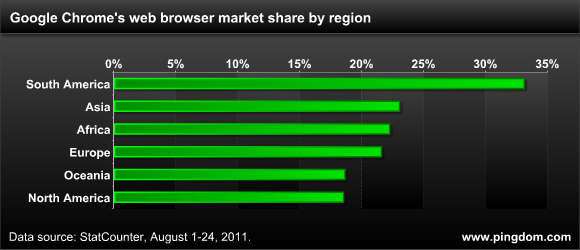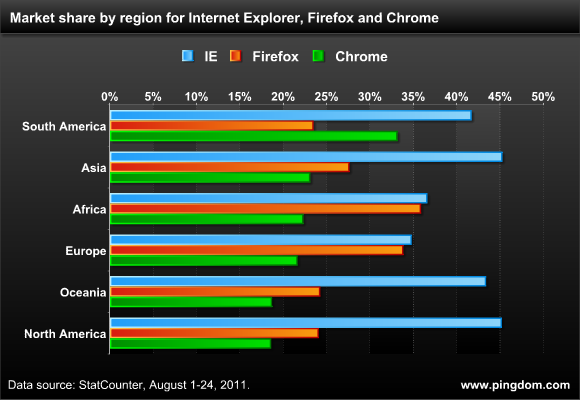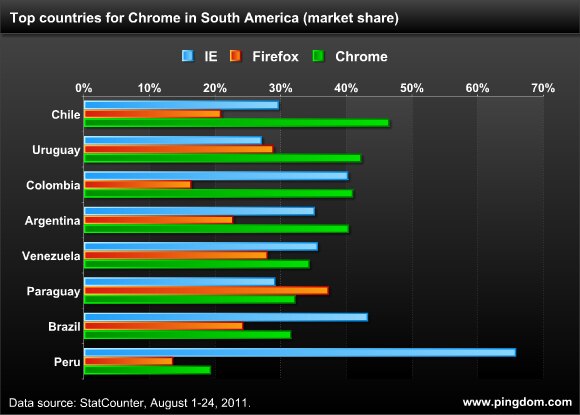 In just a couple of years, Google Chrome has firmly established itself as a web browser to be reckoned with. Where once you spoke of Internet Explorer and Firefox as the two big ones, these days the duo has become a trio. The browser wars are back. Chrome has started to edge out Firefox in some countries, and as you will see in this article, there are actually countries where it’s already become number one.
In just a couple of years, Google Chrome has firmly established itself as a web browser to be reckoned with. Where once you spoke of Internet Explorer and Firefox as the two big ones, these days the duo has become a trio. The browser wars are back. Chrome has started to edge out Firefox in some countries, and as you will see in this article, there are actually countries where it’s already become number one.
This is where South America comes into the picture. Nowhere is Chrome more successful than in that part of the world.
Chrome’s popularity by world region
It’s worth noting that when we talk about market share in this article, we mean share of web usage. The data we have is from StatCounter, which is based on visitor stats from more than three million websites.

As made exceedingly obvious by the above chart, Chrome’s popularity in South America is far ahead of the other world regions.
For added perspective, here is the same chart, sorted the same way, but with the market share of Internet Explorer and Firefox added into the mix.

A couple of takeaways:
- Chrome has passed Firefox in South America and is now behind 33.2% of the web usage in that region.
- In all other regions, the order is: IE, Firefox and then last, Chrome. That said, Chrome still has a significant chunk of the market in each region.
Plus a few general observations about IE and Firefox since we have the data right in front of us. We hope you’ll excuse us for this little tangent:
- The two strongest regions for Firefox in terms of market share are Africa and Europe. Interestingly, it’s almost neck-and-neck with Internet Explorer in both.
- For Internet Explorer, the two strongest regions are North America and Asia.
- The weakest region for Internet Explorer in terms of market share is Europe.
- The weakest region for Firefox is South America. Since it’s also Chrome’s strongest, it’s the only region where Chrome beats Firefox.
But this article is mainly about Google Chrome and its position in South America, so let’s look into that in more detail.
A closer look at Chrome in South America
As you can guess, Chrome has managed to break into first or second place in a number of South American countries. In fact, the vast majority of them. It’s number one in Argentina, Chile, Colombia and Uruguay, and number two in Brazil, Paraguay, Peru and Venezuela.
Here’s what the division between the top three web browsers looks like in these countries (i.e. in South American countries where Chrome is the second-most or most-used web browser):

Just like the other charts, this one was sorted by Chrome’s market share, largest at the top.
Now on to the obvious question…
Why South America?
That is an interesting question, isn’t it? Is Google’s brand and influence stronger in these countries, or are there other forces at play?
To be honest, we’re not sure why Chrome is so successful in South America, but maybe some readers with more insight into that region would like to chime in in the comments?



























